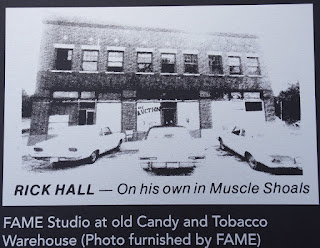Day 6, Friday, May 2, Breakfast and lunch included
Two blueberry muffins, an omelet, and cranberry juice for breakfast at the hotel at 6 A.M.
We finished packing and set our bags outside our room at 7:30 A.M., but we took our overnight bags with us.
At 7:45, we departed for Durham, N.C.
 |
| Plymouth Welcome Center |
We stopped at the Plymouth Welcome Center at 9:40 A.M.
Around 12:15-12:30 P.M., Restroom break at Walmart, Durham, NC.
 |
| Dinner at QShack, Durham, NC |
At 12:45 P.M., lunch at The Original Q Shack, where I ordered a BBQ Sandwich with Mac & Cheese, hushpuppies, and banana pudding. I had enough leftovers for dinner.
At 1:45 P.M., we loaded onto the motorcoach and departed to meet our step-on guide, Brad, with Tobacco Roads Tours.
Our first stop with our guide took us to the Homestead, Factory, and Museum of the Duke family.
We rode by Duke University and were given a brief history of the institution.
Our last stop was the American Tobacco District. Here, we saw the Angus Barn Restaurant, the Lucky Strike water tower, the WUNC radio station, a miniature replica of the Factory, Duke Stadium, the Burts Bees logo (featuring bees), and the North Carolina Innovation Express.
We stopped for dinner around 6 P.M., and Hubby and I ate our leftovers — a BBQ sandwich — from the Q Shack.
Restroom break at Loves at 7:07, Lambsburg, VA
We will arrive at our hotel, Hampton Inn Abington, VA, around nine. (only carry-on bags)
8589 6:58 Breakfast
8590 7:41 A.M. traveled to Corolla, NC 9548-9552
8591-8611 9:42 A.M. Plymouth Welcome Center Plymouth, NC
8612-8613 12:39 P.M. Walmart Durham, NC
8614-8615 12:50 P.M. Duke University Durham, NC
8616-8620 1:15 P.M. University Tower Durham, NC
8621-8655 2:17 P.M. Duke Homestead and Museum Durham, NC 9557-9568
8656-8692 3:32 P.M. Duke University Durham, NC
8693-8773 3:41–4:32 P.M. Durham's American Tobacco District Durham, NC 9572-9600
8774 4:48 leave Durham, NC
8775 7:08 Loves Lambsburg, NC
8777 Receipts
Day 7: Saturday, May 3: Breakfast and lunch included
For breakfast at Hampton Inn Abington, VA, I had scrambled eggs, gravy, biscuits, and bacon, accompanied by cranberry juice. Room 219
Depart for home at 8:30 A.M.
Around 9:30, we stop at Love's for a restroom break
At 10:00 A.M., we shopped at Yoder's Country Market. I bought some pepper jelly, a snack box of cheeses, and some sharp cheese.
At 11:00 A.M., we depart for Myers Pumpkin Patch, where we learn about the farm's history. Everyone buys flowers and vegetable plants, and the whole bottom of the bus is filled with them.
At 12:30 P.M., we depart for home.
 |
| We stopped at Buc-ee's Crossville, TN. |
Around 2 P.M., we stopped at Buc-ee's Crossville, TN, for a restroom break and to shop.
Arrive at Lawrenceburg First Baptist Church around 4:45.
Arrive at 5:45 at Walmart, Florence
Came home, unloaded the car, ate a snack, and went to bed.
8780-8789 Hampton Abington, VA 7:07–7:26 A.M.
8790-8791 9:26 Loves Bulls Gap, TN
8792-8795 10:03 A.M. Yoders Country Market Mosheim, TN
8796-8803 10:55–12:49 P.M. Myers Farm Bulls Gap, TN
8804-8809 1:43–2:05 P.M. Buc ees Crossville, TN
 |
| Coach: Starship Dream, Live, Journey, # AL-BATANI Prevost Muscle Shoals, AL |



































